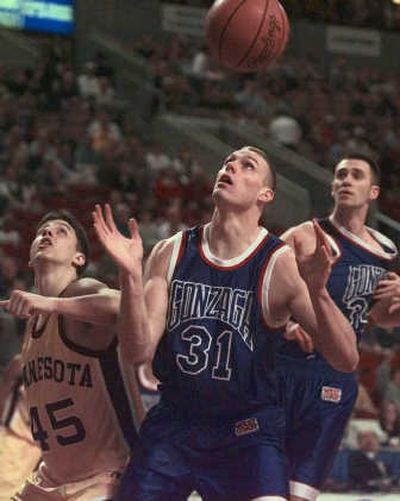John Blanchette: Committee should learn to read compass

So many teams, so much data, so many natural disasters, so little time.
Here’s a toast to the good men and woman on the NCAA tournament selection committee, the impossible job they have in selecting, seeding and siting the 65-team bracket and how well they do despite the odds.
And to the inevitable blunder or two that Hoops America can gnaw on until the first tipoff.
Sure, it’s nitpicking. But as conversation grist goes, it sure beats NIT picking.
So let’s examine one small slice of the bracket – Gonzaga vs. Davidson – with some relevant math:
“Gonzaga, seeded seventh, is 2,130 air miles from its destination in Raleigh, N.C.
“Davidson, seeded 10th, is 154 miles by cross-state bus from the RBC Center, where some 19,000 seats will be filled mostly by Carolinians with a natural inclination to throw their considerable lung power behind an in-state team.
To which the natural question is, what the hell?
Here are the Bulldogs, celebrating their 10th straight appearance in the NCAAs with yet another placement among the top 28 teams in the tournament, reduced to playing a road game in a hostile environment against a hungry upstart from a one-bid conference.
Is this any way to run a national championship?
Well, no.
Or else it’s exactly the way to run a national championship.
Naturally, reaction out there in Zagworld ranged from outrage to indignity to the holstering of a chip on the collective shoulder, while some even rationalized it as a good thing in the light of the Bulldogs’ any team/anywhere scheduling philosophy.
How did Gonzaga freshman Austin Daye put it?
“I’m not worried,” he said. “We’ve been through it. I think that team should be worried.”
As for that seen-it-all March Madness veteran, Gonzaga coach Mark Few, he is not exactly sweating this detail, cockeyed as it is.
“You’re going to have to play somebody really good anyway,” he shrugged. “If you’re not a No. 1 or a No. 2, then you’ve got your work cut out for you in the first round.”
This is entirely the case with Davidson, winner of 22 straight, unbeaten in 20 games of the Southern Conference round-robin, college basketball’s best midmajor still in search of a signature win – which, of course, Gonzaga would most certainly be.
“And we’re basically going to be playing a road game,” Few said, “so we have to prepare for that.”
They aren’t alone.
Butler, one of several Gonzaga wannabes in the Corn Belt, was also given a No. 7 seed by the committee – considerably more eyebrow-raising than the Zags’ seeding, however, given that the Bulldogs from Indiana are 10th in the coaches’ poll, have a 17 RPI and a 29-3 record. As a reward, Butler was sent to a first-round game in Birmingham, Ala., where it will face South Alabama – a mere 250 miles from its Mobile home.
“Reminded me of what happened to us (in 2002),” Few said. “I don’t think Butler jumped for joy when they saw their seed come up and their matchup.”
Correct – the stunned reaction in Indianapolis was pretty much the same as it was at GU’s 2002 selection party at the Inn at the Park when they were seeded sixth and sent to mile-high Albuquerque to play Wyoming.
These two scheduling hiccups seemed especially odd in light of the change six years ago to the “pod” system of siting the tournament, where higher seeds are aided – and, in fact, protected – with placements in their geographic area.
But not all higher seeds, it turns out.
“It’s the way it fell,” said Tom O’Connor, the athletic director at George Mason and this year’s chairman of the selection committee. “We only really protect the first five lines (seeds), and that’s part of the principles and procedures and part of the conversation we have in that room.”
OK, except for the obvious and painfully easy adjustment – sending South Alabama to Raleigh and Davidson to Birmingham, swapping opponents. Both are 10 seeds, the Jaguars still avoid being in the same region as their conference mates Western Kentucky, and Davidson has no such logistical hangup.
Duh, squared.
Of course, Few is very aware that the Bulldogs have profited by such an oversight before – when this Zagmania business started back in 1999. Gonzaga was booked into the tournament that year as a 10th seed and sent all the way to Seattle to play No. 7 Minnesota, holding on for the upset that birthed it all.
Is anyone arguing that the Gonzaga phenomenon hasn’t been good for the tournament?
A home game for a No. 10 seed probably shouldn’t happen “in a perfect world,” Few said.
“But they have so much information that they have to sort through and assimilate that it’s impossible not to end up with a situation like this. I would hope – and I know they do – that they put most of their effort into the selection of the at-larges. That’s the most critical part of the process. Everything filters down from there.
“And when you’re up to that seeding level, I’m not sure you deserve any breaks.”
That’s a pretty healthy outlook – especially since he didn’t get one.